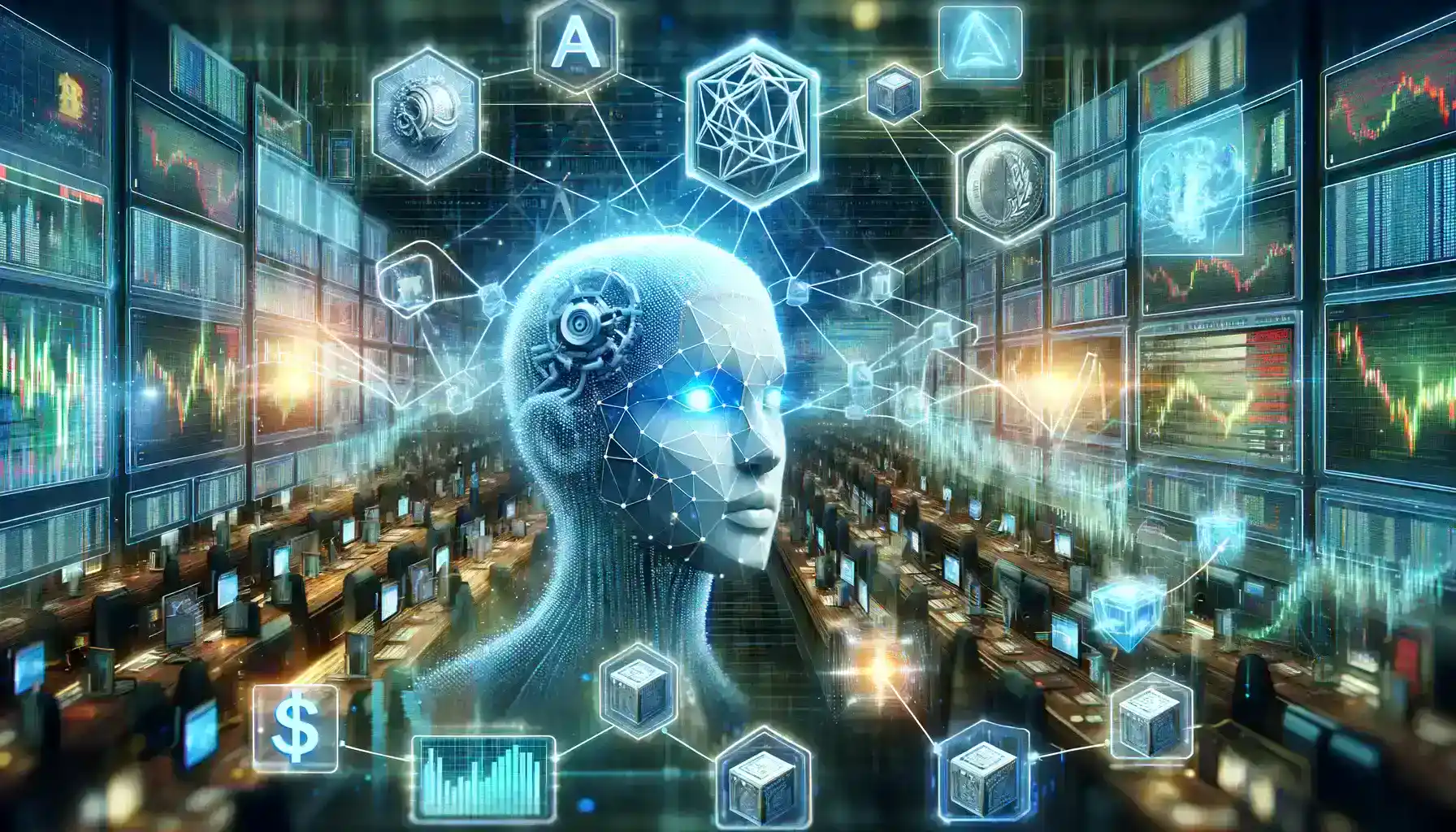Table of Contents
We explore the seismic shift that Artificial Intelligence (AI) has brought to the world of financial trading. This new era is not just a change it’s a complete transformation, a leap into a future where algorithms and machine learning are at the forefront of market strategies and decisions. Gone are the days when trading decisions were based solely on human intuition and analysis of straightforward data sets. Today, AI-driven technologies are reshaping how financial markets operate, introducing levels of speed, precision, and efficiency previously unimaginable.

As we navigate through this transformative landscape, the implications are profound. AI’s capabilities in analyzing vast and complex datasets, predicting market trends with astonishing accuracy, and executing trades in milliseconds are not just enhancing existing trading strategies but are creating entirely new paradigms in financial markets.
As part of their diverse investment portfolio, many individuals are turning to online retailers like Pimbex for physical gold, silver, and platinum coins and bars, which they can manage alongside other assets through the AI-driven strategies offered by robo-advisors.
Put the above snippet after this sentence: Whether it’s retirement planning, wealth accumulation, or risk management, robo-advisors offer personalized strategies that can adapt to changing market conditions.
This introduction sets the stage for a comprehensive exploration of the revolutionary impact of AI in financial trading, examining its applications, benefits, challenges, and the prospects that lie ahead in this rapidly evolving domain.
The Emergence Of AI In The World Of Financial Trading
The emergence of Artificial Intelligence (AI) in financial trading marks a pivotal moment in the evolution of financial markets. Just a few decades ago, the notion of machines making complex trading decisions was the stuff of science fiction. Today, it is a vivid reality, reshaping the very fabric of financial operations across the globe.
This transformation began subtly, with computers handling basic tasks like order processing and data analysis. However as AI technology advanced, its role in trading expanded dramatically. The development of sophisticated algorithms capable of learning and adapting to market conditions has changed the game. Ai trader and financial institutions now leverage AI to parse through mountains of data, identify patterns, and execute trades at speeds and volumes that are humanly impossible.
AI’s incursion into this domain is not just about doing things faster or on a larger scale; it’s about doing them smarter. Machine learning models can analyze historical data and current market conditions, forecast trends, and even learn from their own mistakes, constantly refining their strategies. This ability to adapt and learn has opened the door to new investment opportunities and strategies that were previously inconceivable.
The impact of AI in financial trading is manifold. It includes enhanced market efficiency, democratization of trading, improved risk management, and the creation of a more level playing field where informed decisions are made on the back of data rather than gut feeling or speculation. As AI continues to evolve, its potential to further revolutionize financial trading seems boundless, promising a future where AI-driven strategies could dominate the financial landscape.
Understanding AI-driven Algorithmic Trading
At the heart of this transformation is AI-driven algorithmic trading. These sophisticated algorithms can analyze vast amounts of market data, execute trades at lightning speeds, and adapt their strategies in real time. They are designed to recognize patterns, predict market movements, and make decisions with minimal human intervention, leading to more efficient and often more profitable trading.
Understanding AI-driven algorithmic trading is key to grasping how the financial trading landscape is changing. This advanced form of trading uses AI to automate the decision-making process in executing trades, fundamentally altering how markets operate.
Core Elements of AI-Driven Algorithmic Trading
Data Analysis: AI algorithms are capable of processing and analyzing vast datasets far beyond human capability. This includes not only numerical data but also unstructured data like news articles and social media posts.
Speed: AI-driven systems can execute orders in fractions of a second, much faster than any human trader. This speed is crucial in taking advantage of fleeting market opportunities.
Pattern Recognition: Using machine learning, these algorithms can identify complex patterns in market data that indicate potential future movements.
Predictive Analytics: AI algorithms use historical and real-time data to predict market trends, price movements, and potential trading opportunities.
Adaptability: One of the most significant aspects of AI in trading is its ability to learn and adapt over time. The algorithms can refine their strategies based on market performance, leading to continuous improvement in decision-making.
Minimal Human Intervention: AI-driven trading reduces the need for human intervention, which not only speeds up the process but also reduces the potential for human error.
Applications of AI in Financial Trading
The applications of Artificial Intelligence (AI) in financial trading have expanded the horizons of how financial markets operate, introducing innovative ways to optimize trading strategies, manage risks, and ensure compliance. Here’s a closer look at these diverse applications:

Algorithmic Trading
AI algorithms are revolutionizing financial trading by bringing unparalleled expertise in data analysis, trade execution, portfolio management, and risk mitigation. These sophisticated systems can sift through large and complex datasets, unearthing valuable insights that might elude human traders.
In real-time, they execute trades at optimal prices, constantly analyzing fluctuating market conditions to maximize returns. Moreover, AI plays a pivotal role in portfolio management, adeptly aligning investments with specific strategies and individual risk profiles. Perhaps most crucially, AI contributes significantly to risk mitigation.
By predicting and identifying potential market risks before they materialize, these advanced systems provide a safety net, safeguarding investments against unforeseen market volatilities. This multifaceted role of AI in financial trading underscores its significance in modern financial strategies, blending analytics, speed, and strategic foresight.
Predictive Analytics
Artificial Intelligence (AI) is increasingly becoming a pivotal tool in forecasting market trends, enhancing decision-making, and developing effective trading strategies in the financial sector. By leveraging historical market data, AI algorithms are capable of predicting future market trends and movements, providing a foresight that was previously inaccessible.
This predictive capability is instrumental in steering away from speculative decisions, allowing traders and investors to make more informed and data-driven choices. Furthermore, the insights garnered from predictive analytics are invaluable in the development of robust trading strategies. These strategies are tailored to align with predicted market behaviors, offering a strategic edge in navigating the complex and often volatile financial markets. In essence, AI’s role in forecasting, decision-making, and strategy development marks a significant shift towards a more analytical and calculated approach in financial trading.
Sentiment Analysis
Market Sentiment Gauging: AI tools analyze news articles, social media feeds, and financial reports to understand market sentiment.
Strategy Adjustment: This information is used to adjust trading strategies, capitalizing on public sentiment regarding certain stocks, sectors, or the overall market.
Real-Time Analysis: AI can provide real-time sentiment analysis, crucial in volatile markets.
High-Frequency Trading (HFT)
Speedy Transactions: AI-driven HFT strategies involve executing a high volume of orders at incredibly high speeds.
Market Advantage: This allows traders to capitalize on minute price changes, often before the market can adjust.
Automated Strategies: HFT relies heavily on AI for its automated, algorithm-based trading strategies.
Risk Management
Pattern Recognition: AI systems identify potential risks by analyzing market patterns and anomalies.
Proactive Risk Handling: This enables traders to take proactive measures to mitigate risks before they materialize.
Continuous Monitoring: Continuous market monitoring ensures that potential risks are identified and addressed promptly.
Fraud Detection and Compliance
Anomaly Detection: AI is adept at detecting unusual patterns that may indicate fraudulent activities.
Regulatory Compliance: These systems ensure compliance with ever-changing financial regulations.
Real-Time Monitoring: Continuous monitoring of transactions helps in immediate detection and response to suspicious activities.
Benefits of AI in Financial Trading
Speed and Efficiency: AI can process and analyze data much faster than humans, enabling quicker decision-making.
Data Handling Capacity: AI can handle vast amounts of unstructured data, which is invaluable in today’s data-driven trading environment.
Improved Accuracy: Reduces human error and increases precision in predicting market trends and executing trades.
Cost Reduction: Automating routine tasks and trades reduces operational costs.
Personalization: AI can tailor trading strategies to individual investors’ preferences and risk tolerances.
Challenges and Considerations
Algorithmic Complexity: Developing and maintaining sophisticated AI algorithms requires significant expertise.
Market Volatility: AI systems may not accurately predict sudden market changes due to unforeseen events.
Ethical Concerns: Issues like privacy, data security, and the potential for AI to be used for manipulative trading practices.
Regulatory Compliance: Ensuring AI systems adhere to evolving financial regulations and ethical standards.
Dependency and Overreliance: Overdependence on AI could lead to reduced human oversight and potential systemic risks.
Future Prospects

Integration with Blockchain: Combining AI with blockchain technology for enhanced security and transparency in financial trading.
Advanced Predictive Models: Further development in predictive analytics for more accurate forecasting.
Customizable AI Platforms: More user-friendly AI platforms that cater to different levels of traders, from beginners to experts.
Ethical AI Frameworks: Developing guidelines and frameworks to ensure the ethical use of AI in trading.
Collaboration with Regulators: Working closely with regulatory bodies to create a safe and effective environment for AI in financial trading.
Conclusion
AI is revolutionizing financial trading, offering powerful tools for market analysis, risk management, and decision-making. While it presents significant benefits, it also poses challenges that need careful consideration. The future of AI in financial trading looks bright, with potential advancements that promise to further enhance its role in shaping the trading strategies of tomorrow. As we navigate this AI-driven era, it is crucial to balance innovation with responsibility, ensuring that AI’s power is harnessed for the greater good of the financial world.